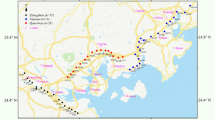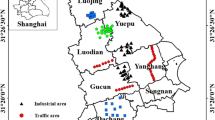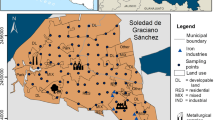Abstract
The combination of magnetic, geochemical, and microstructural methods was used to characterize road dust properties in roadside soils of two sites in southern Finland: a highway (Tuusula no. 45, high traffic volume) and a local road (Mikkeli no. 13, low traffic volume). Significant differences in horizontal (κ) and vertical (χ) distribution of magnetic susceptibility were observed in the investigated roadside soils. These variations were concluded to be mostly associated to traffic volume, which is considered to be a major factor that determines the degree of particle emissions derived from vehicle traffic. Magnetic parameters of hysteresis, isothermal remanence magnetization (IRM) acquisition curves, and thermomagnetic data indicated coarse-grained (pseudo-single-domain/multi-domain) magnetite as the primary magnetic carrier. Scanning electron microscope (SEM) and energy dispersive X-ray spectroscopy (EDX) analyses identified two groups of magnetic materials: angular/aggregate particles (diameter ~2–100 μm) derived from circulation of motor vehicles (e.g., vehicle exhaust emission, cycling of dust in suspension due to vehicular movement, dispersion of road construction materials, and abrasion of tires, brake linings, and road surface), and magnetic spherules (d ~ 3–15 μm) possibly originating from industrial and domestic heating systems. Concentrations of selected trace elements Cu, Zn, and Pb in highway roadside soils were significantly higher than those in local roadside soils.






Similar content being viewed by others
References
Brożek, S., & Zwydak, M. (2000). Total iron contents in selected parent rocks of forest soils in Poland. Roczniki Gleboznawcze (Soil Science Annual), Supplement LII, 67–165 (in Polish).
Day, R., Fuller, M., & Schmidt, V. A. (1977). Hysteresis properties of titanomagnetites: grain size and compositional dependence. Physics of the Earth and Planetary Interiors, 13, 260–267.
Dearing, J. A., Hay, K. L., Baban, S. M. J., Huddleston, A. S., Wellington, E. M. H., & Loveland, P. J. (1996). Magnetic susceptibility of soil: an evaluation of conflicting theories using a national data set. Geophysical Journal International, 127, 728–734.
Evans, M., & Heller, F. (2003). Environmental magnetism. Principles and applications of enviromagnetics (p. 382). New York: Academic.
Fergusson, J. E. (1986). Lead: petrol lead in the environment and its contribution to human blood lead levels. Science of the Total Environment, 50, 1–54.
Finnish Road Administration (2006). Liikennemääräkartta 1:250 000 Uudenmaan tiepiiri (in Finnish).
Finnish Road Administration (2007). Liikennemääräkartta 1:350 000 Kaakkois-Suomen tiepiiri (in Finnish and Swedish).
Frey, A. K., Tissari, J., Saarnio, K. M., Timonen, H. J., Tolonen-Kivimäki, O., Aurela, M. A., et al. (2009). Chemical composition and mass size distribution of fine particulate matter emitted by a small masonry heater. Boreal Environment Research, 14, 255–271.
Gautam, P., Blaha, U., & Appel, E. (2005). Magnetic susceptibility of dust-loaded leaves as a proxy of traffic-related heavy metal pollution in Kathmandu city, Nepal. Atmospheric Environment, 39(12), 2201–2211.
Geological Survey of Finland (1903). Geological map of Finland 1:400 000, Superficial Deposits, sheet C2 Mikkeli.
Geological Survey of Finland (1956). Geological map of Finland 1:100 000, Superficial Deposits, sheet 2043 Kerava.
Geological Survey of Finland (1969). Geological map of Finland 1:100 000, Pre-quaternary Rocks, sheet 2043 Kerava.
Geological Survey of Finland (1990). Geological map of Finland 1:100 000, Pre-quaternary Rocks, sheet 3141 Ristiina.
Goodarzi, F. (2006). Characteristics and composition of fly ash from Canadian coal-fired power plants. Fuel, 85, 1418–1427.
Hanesch, M., Scholger, R., & Rey, D. (2003). Mapping dust distribution around an industrial site by measuring magnetic parameters of tree leaves. Atmospheric Environment, 37, 5125–5133.
Heller, F., Strzyszcz, Z., & Magiera, T. (1998). Magnetic record of industrial pollution in forest soils of Upper Silesia, Poland. Journal of Geophysical Research, 103(B8), 17767–17774.
Hjortenkrans, D. S. T., Bergbäck, B. G., & Häggerud, A. V. (2007). Metal emissions from brake linings and tires—case studies of Stockholm, Sweden 1995/98 and 2005. Environmental Science and Technology, 41, 5224–5230.
Ho, Y. B., & Tai, K. M. (1988). Elevated levels of lead and other metals in roadside soil and grass and their use to monitor aerial metal depositions in Hong Kong. Environmental Pollution, 49, 37–51.
Hoffmann, V., Knab, M., & Appel, E. (1999). Magnetic susceptibility mapping of roadside pollution. Journal of Geochemical Exploration, 66, 313–326.
Huhn, G., Schulz, H., Staerk, H. J., Toelle, R., & Scheuermann, G. (1995). Evaluation of regional heavy metal deposition by multivariate analysis of element contents in pine tree barks. Water, Air and Soil Pollution, 84, 367–383.
Hunt, A., Jones, J. M., & Oldfield, F. (1984). Magnetic measurements and heavy metals in atmospheric particulates of anthropogenic origin. Science of the Total Environment, 33, 129–139.
Jordanova, N., Jordanova, D., & Tsacheva, T. (2008). Application of magnetometry for delineation of anthropogenic pollution in areas covered by various soil types. Geoderma, 144, 557–571.
Kapička, A., Jordanova, N., Petrovský, E., & Podrazsky, V. (2003). Magnetic study of weekly contaminated forest soils. Water, Air and Soil Pollution, 148, 31–44.
Kapička, A., Petrovský, E., Fialova, H., Podrazsky, V., & Dvorak, I. (2008). High resolution mapping of anthropogenic pollution in the Giant Mountains National Park using soil magnetometry. Studia geophysica et geodetica, 52, 271–284.
Karvosenoja, N., Tainio, M., Kupiainen, K., Tuomisto, J. T., Kukkonen, J., & Johansson, M. (2008). Evaluation of the emissions and uncertainties of PM2.5 originated from vehicular traffic and domestic wood combustion in Finland. Boreal Environment Research, 13, 465–474.
Kletetschka, G., Žila, V., & Wasilewski, P. J. (2003). Magnetic anomalies on the tree trunks. Studia geophysica et geodetica, 47, 371–379.
Korhonen, J. V., Säävuori, H., Wennerström, M., Kivekäs, L., Hongisto, H., & Lähde, S. (1993). One hundred seventy eight thousand petrophysical parameter determinations from the regional Petrophysical Programme, Current Research 1991–1992. Geologian tutkimuskeskus, Espoo, 18, 137–141. Special Paper.
Kupiainen, K., & Tervahattu, H. (2005). Size and composition of airborne particles from pavement wear, tires, and traction sanding. Environmental Science and Technology, 39, 699–706.
Laidlaw, M. A., & Filippelli, G. M. (2008). Resuspension of urban soils as a persistent source of lead poisoning in children: a review and new directions. Applied Geochemistry, 23, 2021–2039.
Lecoanet, H., Léveque, F., & Segura, S. (1999). Magnetic susceptibility in environmental applications: comparison of field probes. Physics of the Earth and Planetary Interiors, 115, 191–204.
Magiera, T., Strzyszcz, Z., Kapička, A., & Petrovský, E. (2006). Discrimination of lithogenic and anthropogenic influences on topsoil magnetic susceptibility in Central Europe. Geoderma, 130, 299–311.
Magiera, T., & Zawadzki, J. (2006). Using of high-resolution topsoil magnetic screening for assessment of dust deposition: comparison of forest and arable soil datasets. Environmental Monitoring Assessment, 125, 19–28.
Magiera, T., Strzyszcz, Z., & Rachwał, M. (2007). Mapping particulate pollution loads using soil magnetometry in urban forests in Upper Silesia Industrial Region, Poland. Forest Ecology and Management, 248, 36–42.
Maher, B. A., Moore, C., & Matzka, J. (2008). Spatial variation in vehicle-derived metal pollution identified by magnetic and elemental analysis of roadside tree leaves. Atmospheric Environment, 42, 364–373.
Matzka, J., & Maher, B. A. (1999). Magnetic biomonitoring of roadside tree leaves: identification of spatial and temporal variations in vehicle-derived particulates. Atmospheric Environment, 33, 4565–4569.
Moreno, E., Sagnotti, L., Dinares-Turell, J. D., Winkler, A., & Cascella, A. (2003). Biomonitoring of traffic air pollution in Rome using magnetic properties of tree leaves. Atmospheric Environment, 37, 2967–2977.
Muxworthy, A. R., Schmidbauer, E., & Petersen, N. (2002). Magnetic properties and Mossbauer spectra of urban atmospheric particulate matter: a case study from Munich. Geophysical Journal International, 150, 558–570.
Muxworthy, A. R., Matzka, J., Davila, A. F., & Petersen, N. (2003). Magnetic signature of daily sampled urban atmospheric particles. Atmospheric Environment, 37, 4163–4169.
Petrovský, E., Kapička, A., Jordanova, N., Knab, M., & Hoffmann, V. (2000). Low-field magnetic susceptibility: a proxy method of estimating increased pollution of different environmental systems. Environmental Geology, 39, 312–318.
Sagnotti, L., Macrì, P., Egli, R., & Mondino, M. (2006). Magnetic properties of atmospheric particulate matter from automatic air sampler stations in Latium (Italy): toward a definition of magnetic fingerprints for natural and anthropogenic PM10 sources. Journal of Geophysical Research, 111, B12S22. doi:10.1029/2006JB004508.
Strzyszcz, Z. (1993). Magnetic susceptibility of soils in the areas influenced by industrial emissions. In R. Schulin (Ed.), Soil monitoring (pp. 255–269). Birkhäuser Verlag, Basel: Monte Verita.
Strzyszcz, Z., & Magiera, T. (2001). Chemical and mineralogical composition of some ferrimagnetic minerals occuring in industrial dusts and contaminated soils. Mitteilungen der Deutschen Bodenkundlischen Gesellschaft, 96(2), 697–698.
Strzyszcz, Z., Magiera, T., & Heller, F. (1996). The influence of industrial immissions on the magnetic susceptibility of soils in Upper Silesia. Studia geophysica et geodetica, 40, 276–286.
Szönyi, M., Sagnotti, L., & Hirt, A. M. (2008). A refined biomonitoring study of airborne particulate matter pollution in Rome, with magnetic measurements on Quercus Ilex tree leaves. Geophysical Journal International, 173, 127–141.
Tissari, J., Lyyränen, J., Hytönen, K., Sippula, O., Tapper, U., Frey, A., et al. (2008). Fine particle and gaseous emissions from normal and smouldering wood combustion in a conventional masonry heater. Atmospheric Environment, 42, 7862–7873.
Wang, X., & Yong, Q. (2007). Relationships between heavy metals and iron oxides, fulvic acids, particle size fractions in urban roadside soils. Environmental Geology, 52, 63–69.
Acknowledgements
This study was financially supported by the K. H. Renlund Foundation and the University of Helsinki Foundation. We are grateful to Zygmunt Strzyszcz for providing access to the geochemical laboratory of the Institute of Environmental Engineering in Zabrze, PAS. We would like also to thank Tuula Säämänen, Raija Merivirta (Finnish Road Administration), Taina Nysten, Ritva Väisänen (Finnish Environmental Institute), Eduard Petrovský (Academy of Sciences of the Czech Republic), Teresa Pawlik (Polish Academy of Sciences), Tomas Kohout, and Tiiu Elbra (University of Helsinki) for providing advice and technical support and Mary-Juen Sohn for revising the English manuscript. We acknowledge two anonymous reviewers for constructive comments and suggestions that improved the manuscript.
Author information
Authors and Affiliations
Corresponding author
Rights and permissions
About this article
Cite this article
Bućko, M.S., Magiera, T., Pesonen, L.J. et al. Magnetic, Geochemical, and Microstructural Characteristics of Road Dust on Roadsides with Different Traffic Volumes—Case Study from Finland. Water Air Soil Pollut 209, 295–306 (2010). https://doi.org/10.1007/s11270-009-0198-2
Received:
Accepted:
Published:
Issue Date:
DOI: https://doi.org/10.1007/s11270-009-0198-2




